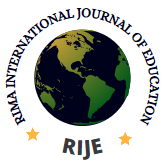Appraising the Relationship between Burnout and Job Satisfactions among Private School Teachers for Quality Education in Wamakko Local Government Area, Sokoto State
Salihu Mukhtar Nawait
Department of Educational Foundations, Faculty of Education, Sokoto State University, Sokoto
Lamido M. Rilwanu
Department of Educational Foundations, Faculty of Education, Sokoto State University, Sokoto
Usman Bukar Abba
Department of Educational Psychology and Counselling, Islamic University, Uganda
Abstract
The study investigated on the relationship between burnout and job satisfactions among private school teachers in Wamakko local government area. It was a cross sectional survey design which consists of 92 respondents (teachers) randomly selected from three purposively selected private schools representing thirty three (33) private schools in the study area. Adopted Maslach Burnout Inventory - Educators Survey (MBI - ES) and Job Satisfactions Survey (JSS) instruments were used for collecting data from the respondents. Two research questions and one hypothesis were formulated which guided the study and the data collected were analysed using Pearson Product Moment Correlations with the help of SPSS Version 20. The results obtained shown the occurrences of burnout among the private school teachers for the first finding. The second finding revealed that there is significant relationship between burnout and job satisfactions of private school teachers in Wamkko local government area. The study recommended that school administrators should collaborate with their respective proprietors to find ways on how to avoid burnout among private schools’ teachers so that job satisfactions can be improved for better result.
Keywords
Burnout, Job Satisfaction, Quality Education
Reference
Aziri, B. (2011). Job Satisfaction: A Literature Review. Management Research and Practice, 3 (4): 77–86.
Apandi O, (2003). Relationship between work stress and job satisfaction among teachers in Secondary School Johor, Malaysia. (Unpublished Thesis). Universiti Teknologi Malaysia
Clandinin, D. J. (2014). Narrative conceptions of knowledge: Towards understanding teacher attrition. Bingley, United Kingdom: Emerald Group Publishing Limited.
Dierking, R. C. & Fox, R. F. (2012). Changing the way I teach: Building teacher knowledge, confidence, and autonomy. Journal of Teacher Education, 64: 129-144. doi:10.1177/0022487112462893
Edwards, J. R., Caplan, R. D. & Harrison, R. V. (1998). Person-environment fit theory: Conceptual foundations, empirical evidence, and directions for future research. In C. L. Cooper (Ed.), Theories of organizational stress (pp. 28-67). NewYork: Oxford University Press.
Freudenberger, H. J. (1975). The staff burn-out syndrome in alternative institutions. Psychotherapy: Theory, Research and Practice, 12 (1): 73-82.
Goldhaber, D., & Cowan, J. (2014). Excavating the teacher pipeline: Teacher preparation programs and teacher attrition. Journal of Teacher Education, 65: 449-462.
Gruenert, S. & Whitaker, T. (2015). School culture rewired: How to define, assess, and transform it. Association for Supervision and Curriculum Development: Alexandria, VA.
Ingersoll, R. (2012) Beginning teacher induction: What the data tell us. Phi Delta Kappan, 93 (8): 47- 51.doi:10.1177/003172171209300811
Krejcie & Morgan (1970) Table for determining sample size for finite population
Lecompte, M. D., & Dworkin, A. G. (1991). Giving up on school: Student dropouts and teacher burnouts. Newbury Park, CA: Corwin Press.
Leiter, M.P., Bakker, A. B. & Maslach, C. (2014). Burnout at work: A psychological perspective. Florence, KY: Psychological Press.
Levine, T. H. & Marcus, A. S. (2010). How the structure and focus of teachers’ collaborative activities facilitate and constrain teacher learning. Teaching and Teacher Education: An International Journal of Research and Studies, 26 (3): 389-398.
Locke, E. A. (1976). The nature and causes of job satisfaction. In M. D. Dunnette (Ed.), Handbook of industrial and organizational psychology (pp. 1297-1349). Chicago: Rand McNally.
Martinetz, C. F. (2012). The stranglehold of state-mandated tests on education in the US: How to teach effectively in spite of this. Charleston, SC: Create Space Publishing.
Maslach, C. (1982). Burnout: The cost of caring. Englewood Cliffs, NJ: Prentice-Hall.Maslach,
- Jackson, S. E. & Leiter, M. P. (1996). Maslach burnout inventory manual (3rd ed.). Palo Alto, CA: Consulting Psychologist Press.
NAPPS (2017) National Association of Proprietor of Private Schools; List of approved private school in Sokoto State; MOBSE, Sokoto.
Parker, P. D., Martin, A. J., Colmar, S. & Liem, G. Q. (2012). Teachers’ workplace wellbeing: Exploring a process model of goal orientation, coping behavior, engagement, and burnout. American Journal of Education, 28 (4): 503-513.
Ratcliff, N. J., Jones, C. R., Costner, R. H., Savage-Davis, E. & Hunt, G. H. (2010). The elephant in the classroom: The impact of misbehavior on classroom climate. Education, 131 (2). Retrieved from questia.com/journals
Reeves, D. (2012). Confront teacher burnout with more safety, time, and R-E-S-P-E- C-T. Educational Leadership, 7 (12). Retrieved from http://www.ascd.org/ascdexpress/vol7/712-toc.aspx
Skaalvik, E. M. & Skaalvik, S. (2011). Teacher job satisfaction and motivation to leave the teaching profession: Relations with context, feelings of belonging and emotional exhaustion. Teaching and Teacher Education, 27 (6): 1029-1038
Weisberg, J. and Sagie, A. (1999). Teachers’ physical, mental, and emotional burnout: Impact on intention to quit. Journal of Psychology, 133 (3): 333-339.
